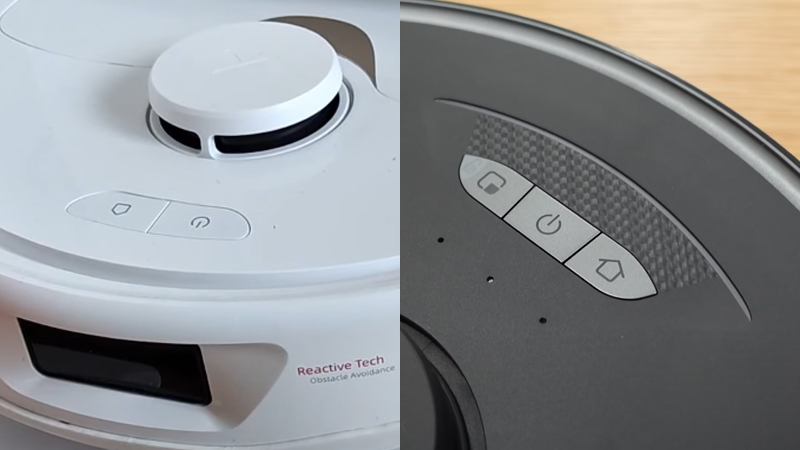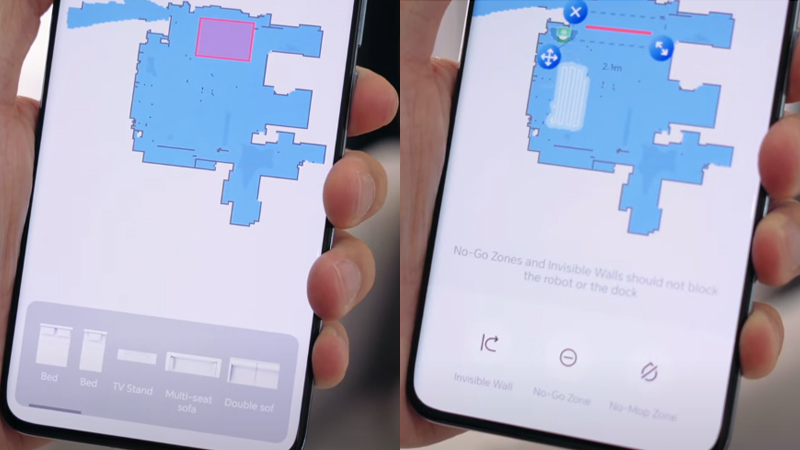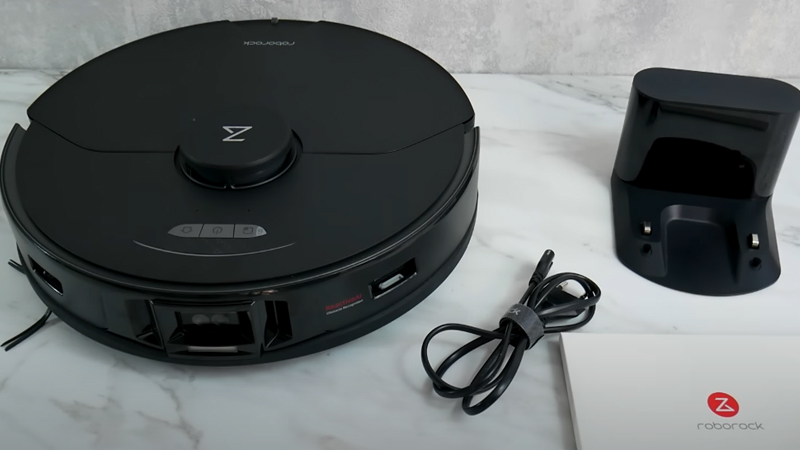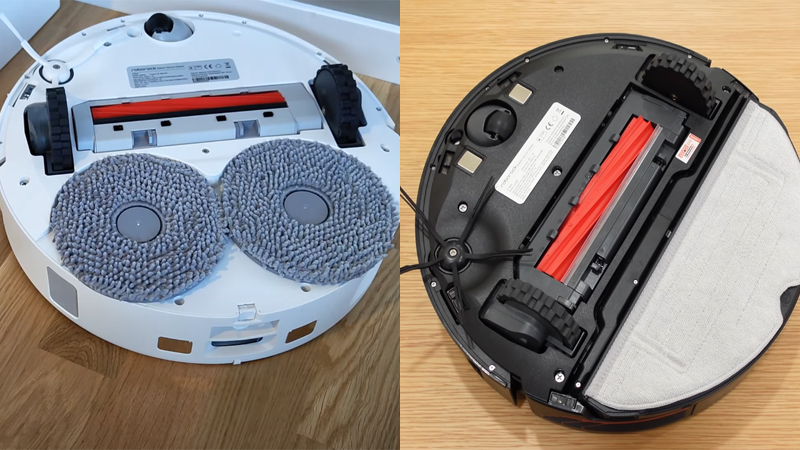Both the Roborock Q Revo vs S7 MaxV are, no doubt, among the greatest smart robot vacuums your money can buy. They all have the ability to map quickly and accurately, thanks to LIDAR technology. They can also save up to four maps and detect obstacles before collisions occur. And via the Roborock app, you will have a lot of settings to control them.
The Roborock S7 MaxV has better overall cleaning performance on carpets as well as being better at picking up hair. Its laser-based system enhances its capability to detect obstacles more effectively, including delicate cables. Some other features that make it stand out from its rival are that its camera can function as a CCTV camera, and you can drive it remotely manually.
The Roborock Q Revo is also a great robot vacuum cleaner. The biggest selling point of this one is a self-cleaning base, so you don’t need to get involved in emptying its dustbin – the base does this dirty job for you.
Roborock Q Revo Vs S7 MaxV: Comparison Chart




Roborock Q Revo Vs S7 MaxV: Differences
The Roborock S7 MaxV triumphs over the Q Revo with a score of 4-2. Let’s delve into my detailed comparison of these two formidable contenders!
Cleaning Performance
Winner: Roborock S7 MaxV
Airflow
| Roborock Q Revo | Roborock S7 MaxV | |
|---|---|---|
| Quiet | 9.68 CFM | 7.7 CFM |
| Balanced | 11.67 CFM | 8.1 CFM |
| Turbo | 14.52 CFM | 10.2 CFM |
| Max | 17.91 CFM | 12.2 CFM |
| Max+ | NA | 13.9 CFM |
Regarding the comparison of airflow, it’s clear that the Q Revo outperforms in terms of the volume of air passing through the main brush roller. However, this superiority doesn’t dictate the outcomes of the cleaning experiments.
Hard Floor
| Roborock Q Revo | Roborock S7 MaxV |
|---|---|
| ≈ 99% | ≈ 98% |
Speaking of cleaning my hardwood floor, the Q Revo and S7 MaxV are nearly even, but the Q Revo got a bit better results at a higher percentage of 99% compared to 98% of the S7 MaxV.
Carpet
| Roborock Q Revo | Roborock S7 MaxV | |
|---|---|---|
| Low-pile Carpet | ≈ 94% | ≈ 97% |
| High-pile Carpet | ≈ 90% | ≈ 96% |
As you can see, there was a slight edge to the S7 MaxV Ultra since it had higher scores on my carpers. It was quite a surprise to me since the Q Revo has higher airflow.
Hair
| Roborock Q Revo | Roborock S7 MaxV | |
|---|---|---|
| 5-inch Strands | ≈ 62% | ≈ 74% |
| 10-inch Strands | ≈ 55% | ≈ 68% |
The S7 MaxV’s performance in terms of picking up hair was not great, but it still proved superior to the Q Revo. I also found a fair amount of long hair remained on their rubber brush rollers post tests, but untangling them was a breeze thanks to the bristle-free design.

Design & Usability
Winner: Roborock S7 MaxV
Dimensions & Weight
| Roborock Q Revo | Roborock S7 MaxV | |
|---|---|---|
| Dimensions (W x H) | 13.9 x 3.8 inches | 13.9 x 3.8 inches |
| Weight | 10 lbs | 10.36 lbs |
The Q Revo and S7 MaxV possess a rounded, puck-shaped form, a hallmark of all Roborocks and many other robots. Compared to their D-shaped counterparts, like the Roomba S9, these circular robots have a greater ease of navigation in tight spaces and are less prone to becoming stuck. They’re somewhat high, at least compared to camera-based iRobot models, but they still effortlessly maneuver under the majority of furniture pieces.
Extractor & Side Brush
Both use a single red bristle-less brush roll rather than a combo one on older Roborocks. This brush design gives them the advantage of anti-tangle hair, not to mention that it’s easier to untangle than a traditional bristled brush roll.

However, they use different side brushes: the Q Revo uses an older three-prong brush versus a rubber five-arm on the S7 MaxV. There’s not much variance in cleaning performance because both efficiently direct debris to the main cleaning path, but I guess the one on the Q5 offers enhanced durability.
Navigation
All Roborock models, including the Q Revo and S7 MaxV, use LIDAR (or laser distance sensor) for map creation. One thing I like about this laser-based technology is its 360-degree scanning ability, which allows it to map extremely accurately and quickly, even in low-light conditions. They can finish mapping and memorizing your living space on the first run, while most camera-based bots need multiple cycles to complete the job.

Regarding the map-saving ability, these Roborocks possess the capability to memorize up to four maps and display them within the Roborock app. So, as soon as they detect they are placed on a new floor or area, they will automatically generate a new map rather than modify the existing one.

Both models can identify and evade obstacles, albeit utilizing distinct sensors. The Q Revo has a front-facing duo-lens camera and two laser sensors, whereas the Q Revo uses an IR sensor. During my testing, both proved adept at avoiding some household obstacles, even fake pet feces, but the Q Revo struggled with coiled wires – but that’s not a massive deal if you have a neat floor surface at all times.
Battery Life
| Roborock Q Revo | Roborock S7 MaxV | |
|---|---|---|
| Battery Life | ≈ 98–201 mins | ≈ 92–190 mins |
| Charging Time | ≈ 210 mins | ≈ 180 mins |
These bots use the same large 5200 mAh lithium-ion battery, so there isn’t much variance in their working lives between charges. Both can generally handle most large homes without recharging frequently and if they run out of juice in the middle of the cycle, they will return to their home bases for recharging and return to their business immediately afterward. This “Recharge and Resume” function makes them almost hands-free robots.
Control
Winner: Roborock S7 MaxV
Manual Control
The degree of control you can get from the physical buttons located on the top of these machines is exceptionally restricted. All you can do is run them with the default cleaning settings by pressing the “Power” button and make them return to the home base by pressing the “Home” button. The S7 MaxV has a “Clean Spot” button, enabling it to work in a small zone to clean up a mess in your kitchen, for example.

App Connectivity
The Q Revo and S7 MaxV are compatible with the Roborock app for setup and remote control, and they share most of the features. Right off the bat, both can save up to 4 maps and can present them in a 3D form beyond the traditional 2D form. They also have a live map function, where you can see the location of these bots in real-time on the map.

Speaking of map editing, both allow dividing rooms and naming them. You can then clean specific rooms on the map, which is handy if you want your robot to prioritize vacuuming high-traffic zones – This can even be done with your voice if you have your own Google Home, Alexa, or Siri. To block these robots from going past some areas, you have the option to set no-go zones, invisible walls, and no-mop zones.

During cleaning, the S7 MaxV can take snapshots of obstacles and show them on the app for you to reference, while the Q Revo only shows cones, no matter what it detects. What’s more, the built-in camera on the S7 MaxV can double as a home security camera, allowing you to keep a remote watch over your residence. You can even control it like you would an RC car, although controlling it this way comes with a learning curve.
Cleaning & Maintenance
Winner: Roborock Q Revo
The S7 MaxV uses a 0.4-liter dust bin compared to a 0.35-liter bin on top of the Q Revo. But the small size of the Q Revo is not much of an issue since it comes out of the box with a bagged self-cleaning base.

So every time the Q Revo’s dust box gets full, it will know its own way back to the clean base to dump the dust and resume its cleaning from where it left off. All the dust and dirt will be sucked out and sent into a 2.7-liter disposable dust bag. So instead of emptying its bin manually too often, a simple replacement of the sealed bag every few weeks suffices. The S7 MaxV doesn’t have this nifty base, but the S7 MaxV Ultra does. Its water tank is also automatically refilled if it runs low.

By the way, both the Q Revo and S7 MaxV come with an E11-rated air filter that is washable and reusable. The app will alert you when it needs to be replaced, and you should check and clean it monthly.
Other Features
Winner: Tie
Noise
| Roborock Q Revo | Roborock S7 MaxV | |
|---|---|---|
| Working | ≈ 45-67 dB | ≈ 59-71 dB |
| Self-Emptying | ≈ 75 dB | None |
Their noise levels max out at the highest power setting, and the Q Revo is the quieter choice despite its higher airflow. Nonetheless, it creates considerable noise, akin to an aircraft preparing for takeoff, during the bin-emptying process at the clean base.
Mopping Ability
Both the Q Revo and S7 MaxV are hybrid robots, meaning they can vacuum and mop at the same time. But while the Q Revo uses two counter-rotating mopping pads, the S7 MaxV features a single semicircular pad. They are generally vacuum robots that can effectively mop floors for good reasons.

Firstly, each is equipped with a mop-lifting system designed to automatically elevate their mop pads upon detecting a carpeted surface, sparing you the hassle of repeatedly attaching and detaching the mop pads while cleaning mixed flooring. However, the Q Revo has the capacity to lift the mopping plate up to 7 mm, contrasting with the S7 MaxV, which only elevates the pad 5 mm above the floor. Therefore, for those with high-pile carpets, it’s crucial to designate no-mop zones through the app for their protection.

For agitating stains, the duo of circular pads on the Q Revo spin in opposite directions, whereas the S7 MaxV features sonic vibration technology, enabling its mop to make 1650 to up to 3000 vibrations per minute. That way, they mop floors more effectively than most other 2-in-1 robots without agitating elements and have nearly identical great results when it comes to handling things like juice stains or BBQ sauce spills. However, these bots can’t pick up liquid, so I recommend avoiding using them on large liquid spills.
Quick Rundown Of Roborock S7 MaxV
- ReactiveAI 2.0. With Roborock’s next generation of obstacle avoidance technology, ReactiveAI 2.0, S7 MaxV can navigate around common domestic hazards using its RGB camera and a new neural processing unit. An additional light turns on in dark rooms, making obstacle recognition as effective at night as during the day. 3D structured light systems supplement the RGB camera and can spot unknown objects, determine their size and location, and allow the robot to navigate around them.
- Next-Level Intelligence. Using its camera, S7 MaxV can now recognize the furniture in your home and place them on the map automatically. It can also identify your floors in each room and recommend cleaning patterns and scrub intensity accordingly.
- The Most Powerful Roborock Robot Vacuum Ever. S7 MaxV has more suction power than any previous Roborock robot vacuum, generating a maximum of 5100 Pa. That’s more than double the power of S6 MaxV. It quickly picks up debris, hair, dust, and more from hard floors and carpets.
Quick Rundown Of Roborock Q Revo
Product Videos
Related Articles to Roborock S7 Maxv
- Roborock Q7 Max Vs S7 MaxV: Which Roborock Is Better?
- Roborock S7 MaxV Vs iRobot S9: A Head-To-Head Comparison
Related Articles to Roborock Q Revo
- Roborock Q Revo Vs Dreame L10S Ultra: Which Smart Vacuum Reigns Supreme?
- Roborock Q Revo Vs Deebot T20: A Confrontation Between Two Self-Emptying Robots
- The Roborock Q Revo Vs S8 Ultra Showdown: A Comprehensive Face-off
- Roborock Q7 Vs Q Revo: Which Option Suits You Best?
- Roborock Q Revo Vs S8: An Ultimate Comparison Between Roborock’s Mid-range Robotic Vacuums
- Roborock Q Revo Vs Q7 Max: Duel of the Roborock Dust-Suckers
- Eufy X9 Pro Vs Roborock Q Revo: A Head-To-Head Comparison
- Roborock P10 Vs Q Revo: What Is The difference?
- Roborock Q Revo Vs Ecovacs X1 Omni: A Duel of Titans!
- Roborock Q Revo vs S7: Battle of the Cleaning Titans!
- Narwal Freo Vs Roborock Q Revo: Which One Is the Best Value Option?
- Roborock Q Revo Vs Xiaomi X10+: A Head-To-Head Comparison
- Roborock Q Revo Vs S7 Max: A Detailed Comparison Of Roborock’s Two Flagships
- Roborock Q Revo Vs S7 MaxV Ultra: Breaking Down The Differences
References:
- Roborock S7 MaxV: https://us.roborock.com/pages/roborock-s7-maxv
- Roborock Q Revo: https://us.roborock.com/pages/roborock-q-revo

Richard B. Schmidt is a prominent figure in the vacuum cleaner industry, boasting over 15 years of expertise. Armed with a Robotics Engineering degree from Northeastern University and a Master’s in Consumer Science from Harvard, his unique blend of technical knowledge and consumer insights positions him as a sought-after authority in vacuum cleaner evaluation. Richard’s career began at Dyson, where he contributed to the development of innovative vacuum models. Transitioning to advocacy and reviews, he co-founded the first Vacuum-focused blog in 2008, offering comprehensive analysis and user guides for various vacuum cleaners. In 2020, he founded RoboMop.net, providing ongoing insights through columns and buyer’s guides.
